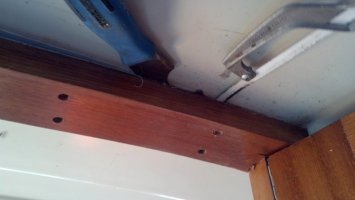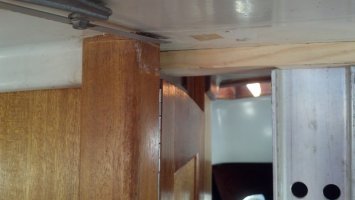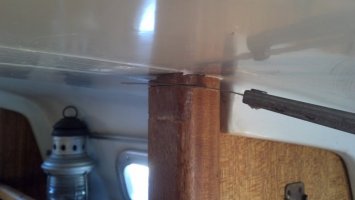Continued...and a question at the end.
Then, I slid a previously cut piece of 1/4" x 4" aluminum into the slots that I cut. It fit right up to the fiberglass flanges on either side of the doorway bulkheads. I then reattached the mantle with new holes drilled through the aluminum.
I then cut a mahogany post to tightly fit up underneath the old mantle. This jammed up under the mantle with substantial pressure. I screwed it onto the existing post that holds the door hinge on. This is the key to the retrofit as it moves support for the mast more directly under the mast.
Here you can see the mast through the hatch, before installing the aluminum and the mahogany support post, and how it doesn't have support directly under it.
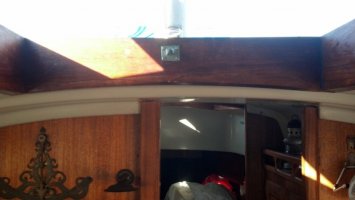
Here is the repair from forward of the bulkhead. Notice that I was able to do this entire repair without removing the door. I did have to trim it a bit on the top of the door because the added thickness of aluminum did not allow the door to close. This was easily accomplished with a cordless jigsaw. Either a previous owner had already trimmed the top of the door once or the factory was rather sloppy because it was a little bit irregular to begin with. The trim job I did would not pass for a shipwrights work.
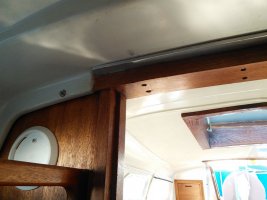
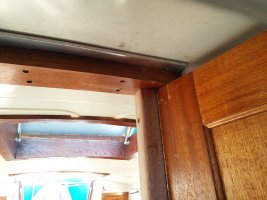
Final positioning of the sistered post and a piece of trim to conceal the joint a bit.
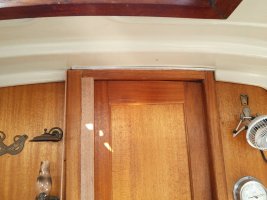
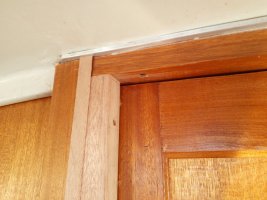
Last but not least, I have to sand and finish.
A couple of thoughts about the job that I did:
The repair found in the E32 book suggests using a square plate of aluminum above the posts on the port side. If you look at the photos, you see there is a fiberglass "flange" that sandwiches the top of the bulkhead right up to the door posts. To me, just using a square plate of aluminum up to the flange would not spread the load enough. You would have to actually cut into the fiberglass up there to add a square of aluminum of the proper size to spread the load. You would end up with a square plate, clamped on one edge, which could tend to bend without support on its outer end. (I hope that is understandable).
The posts on the hinge side go all the way to the floor. Obviously, transferring downward pressure to the keel. The post on the starboard side does not directly transfer any weight to the floor. It is more or less free floating. It is really only there to trim out that side of the doorway. I am a little bit concerned that by installing the aluminum across the doorway and up above this post, too much additional pressure will be applied downward on it and it could want to sheer off. In the end I did it this way anyway because I believe that the added post on the port side will be doing most of the "heavy lifting" for this repair and that the additional pressure on the starboard side will be trivial. I will need to monitor it.
Could the factory have actually cut out the fiberglass "flange" when they installed their aluminum plate? I would really like to see how they did it.
I hope they used mahogany like I did. :dunce: I wish I figured that out before milling the wood. If the rest of it is teak, as I suspect now, the new post I added will be redder in color.
I choose to call it a feature rather than a failure!

Need some help here.
Can anyone help me decide what stain/varnish to use to match the new post to the old? What kind? I have seen a few post about stains but would appreciate some direct thoughts as I am color challenged as well as inexperienced at staining.
Thanks for your thoughts.
Steve
